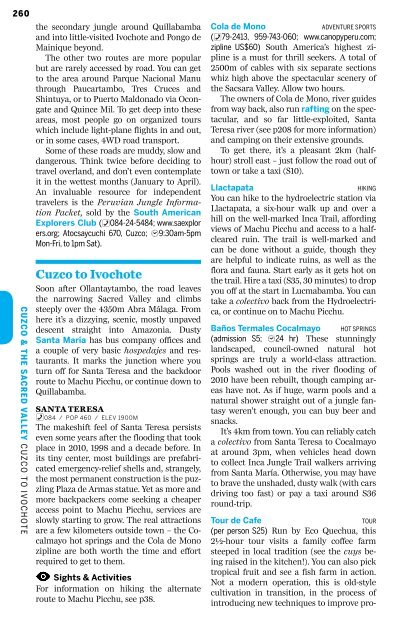peru-8-cuzco-sacred-valley
Create successful ePaper yourself
Turn your PDF publications into a flip-book with our unique Google optimized e-Paper software.
260<br />
Cuzco & the Sacred Valley T C H u E zC H O I K TO E T I VO H E C J H U OT N G E L E<br />
the secondary jungle around Quillabamba<br />
and into little-visited Ivochote and Pongo de<br />
Mainique beyond.<br />
The other two routes are more popular<br />
but are rarely accessed by road. You can get<br />
to the area around Parque Nacional Manu<br />
through Paucartambo, Tres Cruces and<br />
Shintuya, or to Puerto Maldonado via Ocongate<br />
and Quince Mil. To get deep into these<br />
areas, most people go on organized tours<br />
which include light-plane flights in and out,<br />
or in some cases, 4WD road transport.<br />
Some of these roads are muddy, slow and<br />
dangerous. Think twice before deciding to<br />
travel overland, and don’t even contemplate<br />
it in the wettest months (January to April).<br />
An invaluable resource for independent<br />
travelers is the Peruvian Jungle Information<br />
Packet, sold by the South American<br />
Explorers Club (%084-24-5484; www.saexplor<br />
ers.org; Atocsaycuchi 670, Cuzco; h9:30am-5pm<br />
Mon-Fri, to 1pm Sat).<br />
Cuzco to Ivochote<br />
Soon after Ollantaytambo, the road leaves<br />
the narrowing Sacred Valley and climbs<br />
steeply over the 4350m Abra Málaga. From<br />
here it’s a dizzying, scenic, mostly unpaved<br />
descent straight into Amazonia. Dusty<br />
Santa María has bus company offices and<br />
a couple of very basic hospedajes and restaurants.<br />
It marks the junction where you<br />
turn off for Santa Teresa and the backdoor<br />
route to Machu Picchu, or continue down to<br />
Quillabamba.<br />
SANTA TERESA<br />
%084 / POP 460 / ELEV 1900M<br />
The makeshift feel of Santa Teresa persists<br />
even some years after the flooding that took<br />
place in 2010, 1998 and a decade before. In<br />
its tiny center, most buildings are prefabricated<br />
emergency-relief shells and, strangely,<br />
the most permanent construction is the puzzling<br />
Plaza de Armas statue. Yet as more and<br />
more backpackers come seeking a cheaper<br />
access point to Machu Picchu, services are<br />
slowly starting to grow. The real attractions<br />
are a few kilometers outside town – the Cocalmayo<br />
hot springs and the Cola de Mono<br />
zipline are both worth the time and effort<br />
required to get to them.<br />
1 Sights & Activities<br />
For information on hiking the alternate<br />
route to Machu Picchu, see p38.<br />
Cola de Mono<br />
ADVENTURE SPORTS<br />
(%79-2413, 959-743-060; www.canopy<strong>peru</strong>.com;<br />
zipline US$60) South America’s highest zipline<br />
is a must for thrill seekers. A total of<br />
2500m of cables with six separate sections<br />
whiz high above the spectacular scenery of<br />
the Sacsara Valley. Allow two hours.<br />
The owners of Cola de Mono, river guides<br />
from way back, also run rafting on the spectacular,<br />
and so far little-exploited, Santa<br />
Teresa river (see p208 for more information)<br />
and camping on their extensive grounds.<br />
To get there, it’s a pleasant 2km (halfhour)<br />
stroll east – just follow the road out of<br />
town or take a taxi (S10).<br />
Llactapata<br />
HIKING<br />
You can hike to the hydroelectric station via<br />
Llactapata, a six-hour walk up and over a<br />
hill on the well-marked Inca Trail, affording<br />
views of Machu Picchu and access to a halfcleared<br />
ruin. The trail is well-marked and<br />
can be done without a guide, though they<br />
are helpful to indicate ruins, as well as the<br />
flora and fauna. Start early as it gets hot on<br />
the trail. Hire a taxi (S35, 30 minutes) to drop<br />
you off at the start in Lucmabamba. You can<br />
take a colectivo back from the Hydroelectrica,<br />
or continue on to Machu Picchu.<br />
Baños Termales Cocalmayo HOT SPRINGS<br />
(admission S5; h24 hr) These stunningly<br />
landscaped, council-owned natural hot<br />
springs are truly a world-class attraction.<br />
Pools washed out in the river flooding of<br />
2010 have been rebuilt, though camping areas<br />
have not. As if huge, warm pools and a<br />
natural shower straight out of a jungle fantasy<br />
weren’t enough, you can buy beer and<br />
snacks.<br />
It’s 4km from town. You can reliably catch<br />
a colectivo from Santa Teresa to Cocalmayo<br />
at around 3pm, when vehicles head down<br />
to collect Inca Jungle Trail walkers arriving<br />
from Santa María. Otherwise, you may have<br />
to brave the unshaded, dusty walk (with cars<br />
driving too fast) or pay a taxi around S36<br />
round-trip.<br />
Tour de Cafe<br />
TOUR<br />
(per person S25) Run by Eco Quechua, this<br />
2½-hour tour visits a family coffee farm<br />
steeped in local tradition (see the cuys being<br />
raised in the kitchen!). You can also pick<br />
tropical fruit and see a fish farm in action.<br />
Not a modern operation, this is old-style<br />
cultivation in transition, in the process of<br />
introducing new techniques to improve pro-


